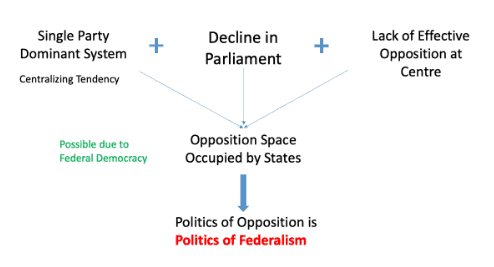UPSC Articles
Indian Polity Federalism
TOPIC:General Studies 2:
- Functions and responsibilities of the Union and the States, issues and challenges pertaining to the federal structure.
Indian Constitution – Unitary tilt & Future Federal Challenges
Context:
- Kerala Legislative Assembly passing a resolution stating that Citizenship Amendment Act (CAA) passed by Parliament contradicts the basic values and principles of the Constitution.
- West Bengal Government had put anti-CAA advertisements on its websites using public funds which was later withdrawn on order of High court.
- Several States have declared that they will not participate in NPR (National Population Register) exercise which will be used as basis for NRC (National Register of Citizens)
In this background where Centre and States are on conflicting stands it becomes important to analyse the Constitutional features of Federalism.
The below pictorial representation explains the plausible reason for the emergence such type of opposition by States

Daily Current Affairs IAS | UPSC Prelims and Mains Exam – 9th January 2020
Some of the features of Federalism in India:
- Division of Powers: Presence of Union List, State list and Concurrent list
- Written Constitution
- Supremacy of the Constitution
- Rigidity of the Constitution
- Independent Judiciary
- Bicameralism
However, there are various other features that makes the Constitution tilted towards Centre (Unitary bias)
- Single Constitution
- Single Citizenship
- Integrated Judiciary
- Flexibility of the Constitution under Article 368
- Appointment of State Governors by the State
- All India Services – Controlled by Centre but deputed in State administrative set up
- Emergency Provisions
- No equality of State representation in Rajya Sabha
- Parliament’s authority over State List
- Veto Over State Bills
- Article 256 of the Constitution obligates the State government to ensure implementation of the laws made by Parliament. If the State government fails to do so, the Government of India is empowered to give “such directions to a State as may appear… to be necessary” even resulting in dismissal of the State government and imposition of Presidents Rule under Article 356 & 365.
Why was the Constitution structured with Unitary Bias?
The Indian Constitution is not based on American Model but based on Canadian Model. The reason why India adopted Canadian model was because:
- The way federal governments are formed is by way of disintegration and not by the way of agreement amongst the states coming together like in American Federation
- The States have no right to secede from the federation. Giving this right would have further strengthened the “fissiparous tendencies” in newly born Nation which was reeling under the aftereffects of Partition. Thus to avoid such secession tendencies a Strong centre was created.
Working of Federalism
- However, Indian working of Constitution has shown that Federalism is not just limited to legal space where there is division of Power between Centre & State governments but Federalism has peculated into Public participation in Democratic process.
- Federalism has been reflected in people’s voting behaviour. There are examples of huge vote swings between national and State elections, separated by only a few months, in the same constituencies. This indicates that people make distinction between regional concerns and National concerns.
As shown in the diagram above, the emergence of Single Party Dominance system since 2014 along with vacating of Opposition Space (partly due to decline in Parliament) has allowed regional & State governments to occupy this space.
This opposition by State governments now poses a threat to Federalism and questions the bias provided for in the original Constitution especially when India is integrated now more than ever (declining fissiparous tendencies)
Decline of Parliament involves
- Using disruption as a tactic to oppose legislative discussions and stall executives agenda
- Misuse of Office of Speaker to push forward ruling party’s agenda without meaningful debates (ex: Certifying bills as Money bill so as to avoid scrutiny by Rajya Sabha)
- Tyranny of Political Parties: The presence of Tenth Schedule prohibits legislators to freely air their opinion. Instead they are supposed to follow their Party’s dictates thus prioritising Political Party’s interest over and above the Public interest
- Criminalization of Politics: 43% of the 17th Lok Sabha members (2019 general elections) have criminal charges against them according to Association of Democratic reforms
- Less number of time spent on legislative deliberations: In fact, in the last 10 years, the lower House has met for an average of 70 days a year.
- Lack of Leader of Opposition since 16th Lok Sabha: With no political party gaining 10% of the strength of the Lower House, the position has remained vacant. This has effectively weakened the opposition voice in various platforms & committees which hold government accountable
But All is not Gloomy, this is because
- There is thrust by the Central government on Cooperative & Competitive Federalism, in spite of having majority in Lok Sabha
- Political and Administrative leadership realizes that there has to be decentralization where States will act as engines of growth and Centre will act as facilitator of growth. The 42% devolution of funds from Central pool of taxes to State is a reflection of this sentiment
- The example of GST Council clearly shows that Constitution provides an outlet for Sates to engage collaboratively with Centre so as to get its concerns addressed.
- Federalism is a Basic Structure of Constitution: Examples of Indian Judiciary reversing some of the Central government’s decisions like the imposition of Article 356, reversing President’s or Speaker’s decision (Arunachal Pradesh, Maharashtra, Karnataka) shows that Federalism will be an integral of our system.
Connecting the dots
- Will the emergence of single party system good or bad for Democracy and economic development?
- Is opposition necessary in a Democratic Polity especially it when it creates obstacles in economic development weakening Indian hand to deal with China.











